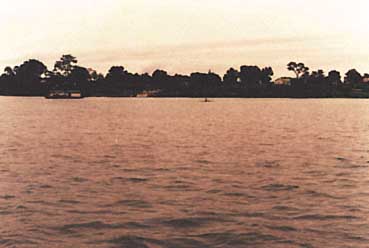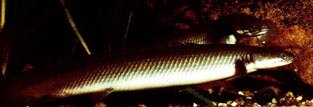Individual Fish Description Page


This page will give a completely detailed profile of the
selected fish, from A to Z. The profiled fish will be
chosen randomly by Badman, and will come from the complete
genre of tropical fish. I will try to update the profile
on a monthly basis. If you have a specific fish you want
profiled please vote for it in the favorite fish poll on the main index page.


Photo from "aquarium fish"
POLYPTERUS SENEGALUS
Overview:
An ancient fish family, they have been around since the Mesozoic era. They are a very hardy fish and can become quite tame in a home aquarium.
Quick stats:
| size: | up to 12 inches
|
| tank: | 48 inches |
| strata: | bottom |
| pH: | 6 to 7.5 |
| Hardness: | soft to hard |
| temperature: | 77o to 89o f |
Classification:
| Order: | Polypteriformes |
| Sub-order: | none |
| Family: | Polypteridae |
| Genera: | Polypterus |
Common name:
Senegal Bichir Bichir, Sailfins
Distribution:
Central Africa, Lake Albert, Rudolph and Chad also found in Gambia, Niger and Senegal.
General Body Form:
Long and slender in form, they are noted for a bunch of primitive features. Their scales are hard and shiny and are different from other fish by their rhomboid shape. The Dorsal fin is really made up of a bunch of smaller fins, kind of looking like saw edged teeth. This fin also gives them one of the common names (Sailfins) that we know them by. Unlike the more modern fish the Bichirs do not have a swim bladder but have developed an air breathing organ, which acts similar to a lung and allows them to gulp at the surface for air. This organ also allows them to live in very Oxygen poor water conditions. Another interesting feature of the fish is like Amphibians (Salamanders and Newts) The young must go through a larval stage in which they have external gills. These will be absorbed as the fish matures.
Coloration:
Not an overly striking fish, The base color is Silver Gray to Yellow Brown. The underside is somewhat White and the fins are a pale Yellow. What the Bichirs lack in color they make up with their personality.
Maintenance:
We are starting to see more and more of these fish imported and they tend to do well in aquaria. They are a bottom dweller and do most of the food foraging at night. They are Carnivorous, but this should be no problem as they will thrive on earthworms, tubifex worms and fish flesh cut into strips. In nature they would hunt for insects and other invertebrates. The tank should be large and not overly bright. You must provide plenty of hiding places either as rockwork or driftwood. Make sure if your keeping more than one that each fish has its own place to hide. You are likely not to see them much during the day but at feeding time they will come out and forage. They have a highly developed sense of smell and will know as soon as food is added to the tank. They can be territorial to each other, but if they have their own space this will be minimized. They can be kept with other medium to large sized non aggressive fish. They have a reputation as being great escape artists and can move on land for short lengths, so take proper precautions with your tank cover.
Biotope:
Vegetation ladden, marshy waters in Central and West Africa.

Photo: A.Anene
Lake Oguta, Imo State, Nigeria. The Senegal Bichir is a native species of this lake. for more info on this lake and Biotope please visit the World Lake Database
Breeding:
Although many Bichirs have been raised to sexual maturity, little is known on the breeding.
It is said that the males Anal fin is wider than the females. Males initiate spawning, the female laying a few hundred eggs near his hand-like anal fin. Young hatch out in about four days. A water change with slightly cooler water can stimulate the spawning. Remove any eggs to a rearing tank and feed with baby brine shrimp moving on to the larger food as they grow. The young have external gills.
Your comments:
From: Patti Alberg
Date:01/11/2001
We've had him 3 days and he just ate my albino frog and Beta...but
somefish had already eaten the beta's tail, so he was much smaller that he
should have been. I was told this fish "was a good community tank fish" I think
that was a lie, but he is pretty cool to watch.
|



back to the fish profile page.

Email:
badman2nd@hotmail.com






